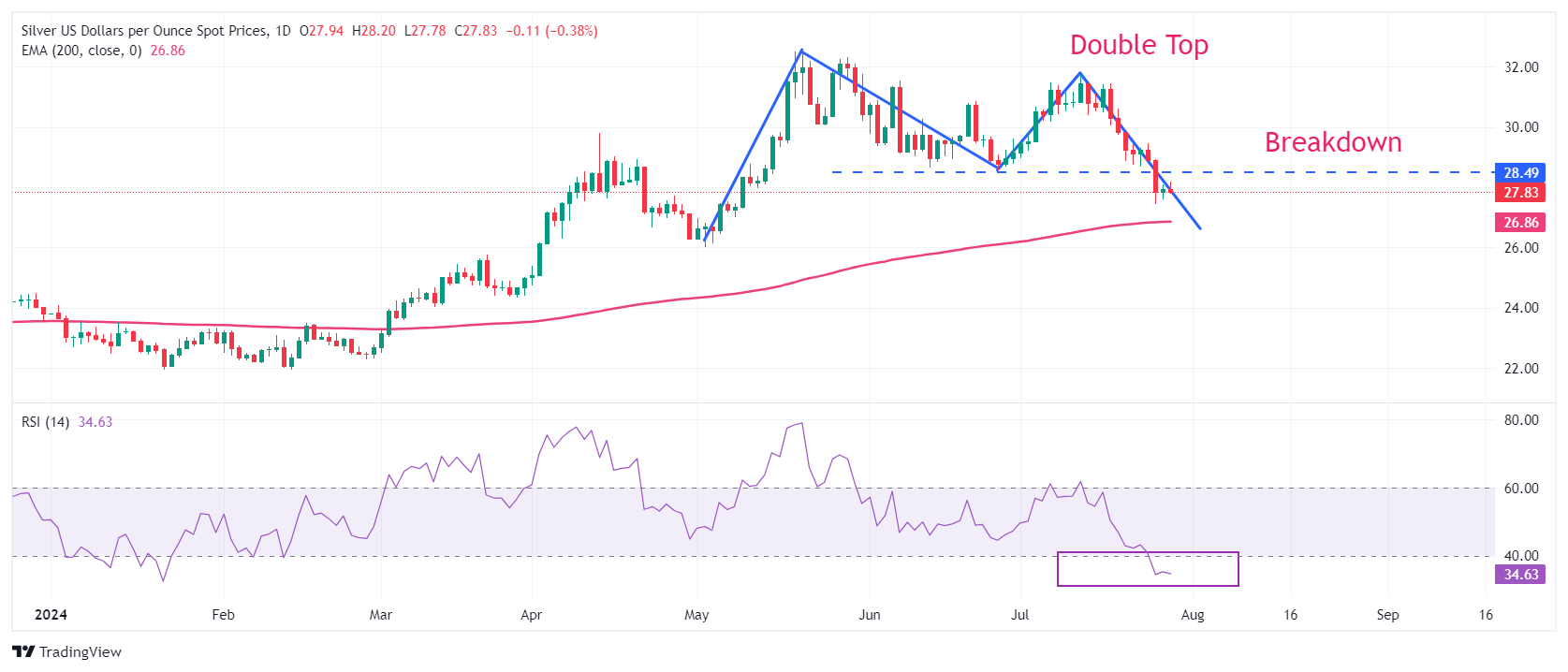Silver Price Forecast: XAG/USD juggles around $28 as investors await Fed policy announcement
- Silver price hovers around $28.00 with Fed policy meeting in focus.
- The Fed is expected to cut interest rates in September.
- Renewed risks of Middle East tensions improve safe-haven appeal.
Silver price (XAG/USD) trades in a tight range near $28.00 in Monday’s North American trading session. The white metal stays on the sidelines with a focus on the Federal Reserve’s (Fed) monetary policy decision, which will be announced on Wednesday.
The precious metal steadies amid firm speculation that the Fed will deliver a dovish guidance on interest rates with an unchanged decision leaving them at their current level for the eighth time in a row. The Fed is expected to acknowledge that inflation has returned to the path of 2% with some progress and will highlight upside risks to labor market conditions.
Meanwhile, renewed risks of widening Middle East woes have also offered a temporary cushion to the Silver price. The precious metals, such as Gold and Silver, tends to perform better amid geopolitical uncertainty. The safe-haven appeal of the US Dollar (USD) has also improved. The US Dollar Index (USD), which tracks the Greenback’s value against six major currencies, jumps to a fresh two-high high to near 104.70.
10-year US Treasury yields slump to 4.18% on expectations that the Fed will start reducing interest rates from the September meeting. Lower yields on interest-bearing assets reduces the opportunity cost of holding an investment in non-yielding assets, such as Silver.
Silver technical analysis
Silver price weakens after a breakdown of the Double Top formation below June 26 low near $28.60 on a daily timeframe. A breakdown of the aforementioned chart pattern results in a bearish crossover. The Silver price is expected to find a temporary cushion near the 200-day Exponential Moving Average (EMA), which trades around $26.86.
The 14-day Relative Strength Index (RSI) shifts into the bearish range of 20.00-40.00, suggesting that a bearish momentum is intact.
Silver daily chart

Silver FAQs
Silver is a precious metal highly traded among investors. It has been historically used as a store of value and a medium of exchange. Although less popular than Gold, traders may turn to Silver to diversify their investment portfolio, for its intrinsic value or as a potential hedge during high-inflation periods. Investors can buy physical Silver, in coins or in bars, or trade it through vehicles such as Exchange Traded Funds, which track its price on international markets.
Silver prices can move due to a wide range of factors. Geopolitical instability or fears of a deep recession can make Silver price escalate due to its safe-haven status, although to a lesser extent than Gold's. As a yieldless asset, Silver tends to rise with lower interest rates. Its moves also depend on how the US Dollar (USD) behaves as the asset is priced in dollars (XAG/USD). A strong Dollar tends to keep the price of Silver at bay, whereas a weaker Dollar is likely to propel prices up. Other factors such as investment demand, mining supply – Silver is much more abundant than Gold – and recycling rates can also affect prices.
Silver is widely used in industry, particularly in sectors such as electronics or solar energy, as it has one of the highest electric conductivity of all metals – more than Copper and Gold. A surge in demand can increase prices, while a decline tends to lower them. Dynamics in the US, Chinese and Indian economies can also contribute to price swings: for the US and particularly China, their big industrial sectors use Silver in various processes; in India, consumers’ demand for the precious metal for jewellery also plays a key role in setting prices.
Silver prices tend to follow Gold's moves. When Gold prices rise, Silver typically follows suit, as their status as safe-haven assets is similar. The Gold/Silver ratio, which shows the number of ounces of Silver needed to equal the value of one ounce of Gold, may help to determine the relative valuation between both metals. Some investors may consider a high ratio as an indicator that Silver is undervalued, or Gold is overvalued. On the contrary, a low ratio might suggest that Gold is undervalued relative to Silver.


